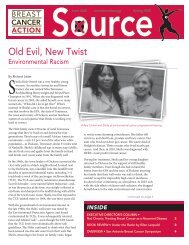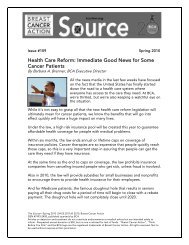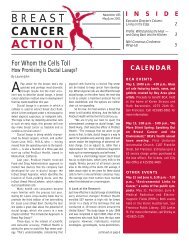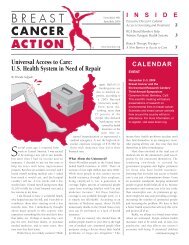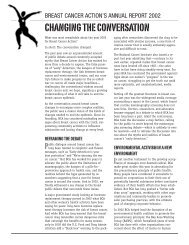Download Newsletter #61 in PDF Format - Return to Home Page ...
Download Newsletter #61 in PDF Format - Return to Home Page ...
Download Newsletter #61 in PDF Format - Return to Home Page ...
Create successful ePaper yourself
Turn your PDF publications into a flip-book with our unique Google optimized e-Paper software.
8<br />
September/Oc<strong>to</strong>ber 2000<br />
Breast Cancer Action<br />
Circadian Rhythms<br />
cont<strong>in</strong>ued from page 1<br />
found lower breast cancer rates, as predicted,<br />
<strong>in</strong> this population; a third study did not.<br />
Arendt also found no differences<br />
between mela<strong>to</strong>n<strong>in</strong> levels <strong>in</strong> women with<br />
benign and malignant breast tumors (an<br />
American study has found a difference). S<strong>in</strong>ce<br />
mela<strong>to</strong>n<strong>in</strong> levels dim<strong>in</strong>ish with age, Arendt<br />
stresses that epidemiological research should<br />
control for this variable. Small pilot studies<br />
are <strong>in</strong>herently limited but, as Arendt<br />
observes, “these studies are not cheap, and<br />
it’s hard <strong>to</strong> get fund<strong>in</strong>g for a large, prospective<br />
study with negative pilot data.”<br />
Epidemiologist Richard Stevens, meanwhile,<br />
po<strong>in</strong>ts <strong>to</strong> a study that found elevated<br />
breast cancer rates among F<strong>in</strong>nish flight attendants,<br />
not<strong>in</strong>g that the <strong>in</strong>cidence is <strong>to</strong>o high <strong>to</strong><br />
be accounted for solely by <strong>in</strong>creased radiation<br />
exposure. Disruption of circadian rhythms<br />
might well be a causative fac<strong>to</strong>r <strong>in</strong> these<br />
cancers, he says. And alcohol disrupts sleep,<br />
which <strong>in</strong> turn could suppress mela<strong>to</strong>n<strong>in</strong>,<br />
perhaps expla<strong>in</strong><strong>in</strong>g why excessive alcohol<br />
consumption <strong>in</strong>creases breast cancer risk.<br />
W<strong>in</strong>dows of Time<br />
William Hrushesky, M.D., a cl<strong>in</strong>ical<br />
researcher at the Strat<strong>to</strong>n VA Medical Center<br />
<strong>in</strong> Albany, New York, believes that research<br />
on cycles should extend beyond circadian<br />
rhythms <strong>to</strong> menstrual and seasonal cycles.<br />
We already know, he po<strong>in</strong>ts out, about certa<strong>in</strong><br />
“w<strong>in</strong>dows of time” that can optimize the<br />
effectiveness of cancer therapy while reduc<strong>in</strong>g<br />
side effects. Cancer drugs should be adm<strong>in</strong>istered<br />
<strong>in</strong> the morn<strong>in</strong>g, when bone marrow and<br />
gut proliferate at two <strong>to</strong> three times the nighttime<br />
rate. In a study of women with ovarian<br />
cancer, optimal tim<strong>in</strong>g of chemotherapy<br />
improved efficacy from 11 <strong>to</strong> 44 percent.<br />
Perform<strong>in</strong>g breast surgery <strong>in</strong> the early luteal<br />
phase of the menstrual cycle (days 14-21)<br />
yields a 25 percent advantage <strong>in</strong> ten-year survival<br />
over surgery <strong>in</strong> other phases, he says,<br />
while mammography screen<strong>in</strong>g is less effective<br />
<strong>in</strong> the luteal phase. (The day menstrual<br />
bleed<strong>in</strong>g beg<strong>in</strong>s is considered the first day<br />
of the cycle.) Pap smears for cervical cancer<br />
are more sensitive dur<strong>in</strong>g the summer,<br />
Hrushesky says, and breast cancer is most<br />
often diagnosed <strong>in</strong> the spr<strong>in</strong>g.<br />
“We are do<strong>in</strong>g great harm because we<br />
ignore cycles,” he charges. His work has been<br />
ridiculed and ignored, he says, because of<br />
<strong>in</strong>ertia and l<strong>in</strong>ear th<strong>in</strong>k<strong>in</strong>g <strong>in</strong> the research<br />
community. Although five prospective studies<br />
on the tim<strong>in</strong>g of breast cancer treatments are<br />
now <strong>in</strong> progress, he predicts that only one, an<br />
Italian study, is properly designed <strong>to</strong> yield<br />
mean<strong>in</strong>gful results.<br />
Translat<strong>in</strong>g the Data<br />
While little of the research that exists on<br />
circadian rhythms is def<strong>in</strong>itive and can be<br />
translated <strong>to</strong> real-world practice, some lends<br />
itself <strong>to</strong> an approach based on the best-available<br />
evidence. The good news is that<br />
starlight, moonlight, and lightn<strong>in</strong>g all fall outside<br />
the spectrum of light that depresses<br />
mela<strong>to</strong>n<strong>in</strong>. Researchers speculate that the<br />
body is made aware of light<strong>in</strong>g not through<br />
vision but through another system <strong>in</strong> the<br />
ret<strong>in</strong>a — so if your bedroom w<strong>in</strong>dow is next<br />
<strong>to</strong> a street light, eye shades or a light-tight<br />
bl<strong>in</strong>d are harmless ways <strong>to</strong> keep the mela<strong>to</strong>n<strong>in</strong><br />
flow<strong>in</strong>g. Red-spectrum light is least disruptive<br />
and therefore best for night lights or<br />
clocks with illum<strong>in</strong>ated time displays; bluegreen<br />
light is most disruptive.<br />
For advocates, research <strong>in</strong><strong>to</strong> circadian<br />
rhythms offers plenty of scope for action.<br />
Mela<strong>to</strong>n<strong>in</strong> is a product that can’t be<br />
patented, which suggests why research <strong>in</strong><strong>to</strong><br />
its therapeutic potential is so sluggish. Also,<br />
circadian rhythms lie outside the realm of<br />
much of cancer research, so proposals are<br />
Celebrat<strong>in</strong>g a Decade of Action<br />
Breast Cancer Action marked its tenth anniversary on July 20 with a party featur<strong>in</strong>g the<br />
premiere performance of a theatrical civil action by Opera Piccola, a Bay Area theater<br />
company. The theater piece was developed <strong>to</strong> be taken <strong>to</strong> the street as an educational and<br />
organiz<strong>in</strong>g <strong>to</strong>ol. Before the performance, BCA Executive Direc<strong>to</strong>r Barbara Brenner (left)<br />
and Board President Jane Sprague Zones (right) led friends and supporters of the organiza -<br />
tion <strong>in</strong> an unexpectedly spirited homage <strong>to</strong> those who have died of breast cancer: a round<br />
of foot-s<strong>to</strong>mp<strong>in</strong>g and cheers. “It’s cus<strong>to</strong>mary at breast cancer events <strong>to</strong> honor the spirit of<br />
those we have lost by observ<strong>in</strong>g a moment of silence,” Brenner <strong>to</strong>ld the crowd of nearly 300.<br />
“But I’ve never believed that silence accomplishes anyth<strong>in</strong>g.”<br />
more apt <strong>to</strong> flounder. F<strong>in</strong>ally, as William<br />
Hrushesky argues, we need <strong>to</strong> put hardwon<br />
knowledge about “w<strong>in</strong>dows of time” <strong>to</strong><br />
better use.<br />
For me, the National Action Plan on<br />
Breast Cancer’s workshop recalled an early<br />
radicaliz<strong>in</strong>g experience, a 1991 conference at<br />
which Congressional representative Pat<br />
Schroeder blasted cancer researchers for<br />
exclud<strong>in</strong>g women from cl<strong>in</strong>ical trials. Because<br />
women’s cyclical physiology doesn’t fit the<br />
l<strong>in</strong>ear shoe of fashionable science, she<br />
charged, “they even used male rats <strong>to</strong> study<br />
breast cancer.” F<strong>in</strong>ally, a critical mass of<br />
researchers is say<strong>in</strong>g that cycles matter. ◆<br />
Sharon Batt currently holds the Nancy Ruth<br />
chair <strong>in</strong> women’s studies at Mount Sa<strong>in</strong>t<br />
V<strong>in</strong>cent University <strong>in</strong> Halifax. She is the<br />
author of Patient No More: The Politics of<br />
Breast Cancer (Gynergy Books, 1994) and<br />
cofounded Breast Cancer Action Montreal.<br />
1 See the National Geophysical Data Center’s Web<br />
site (www.ngdc.noaa.gov). Click on “DMSP Data<br />
Archive,” then on “City Lights at Night,” which will<br />
l<strong>in</strong>k you <strong>to</strong> a map show<strong>in</strong>g nighttime lights around<br />
the world.



